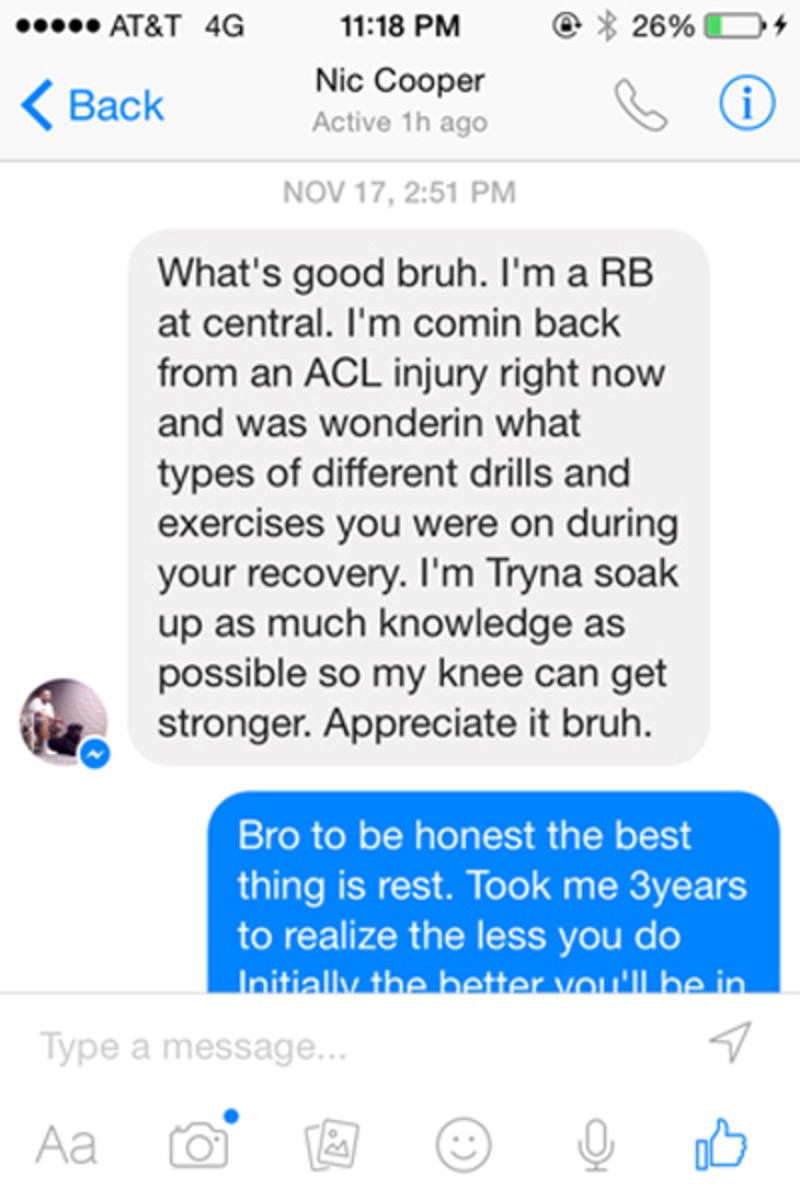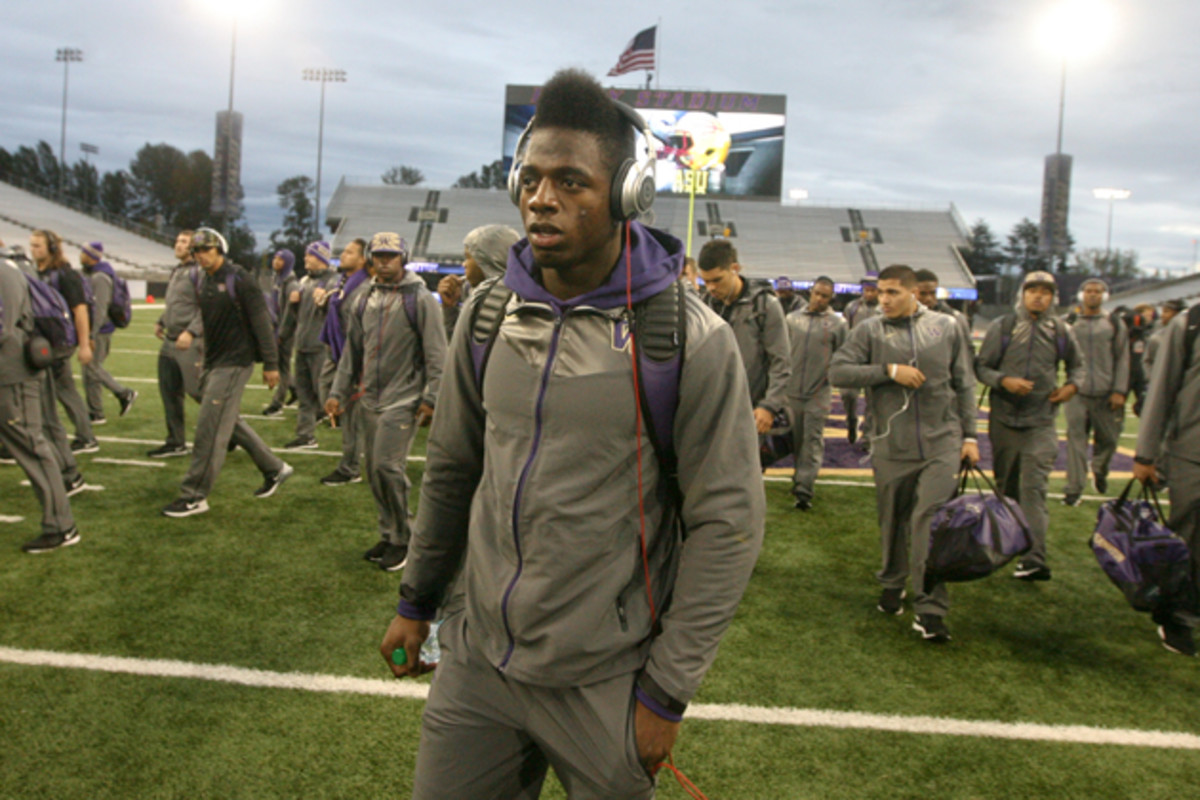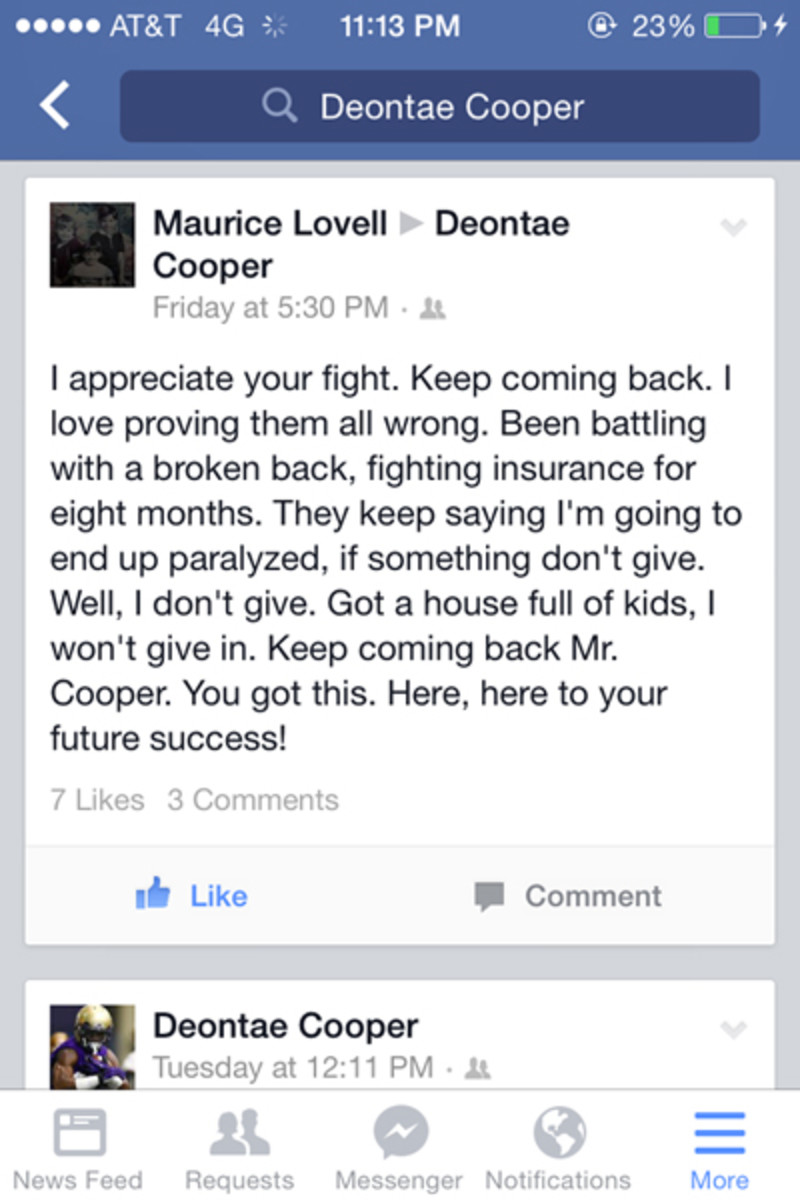After three ACL injuries, UW's Deontae Cooper is still aiming for NFL career

SEATTLE – Contrary to reasonable assumptions, Deontae Cooper does not break mirrors every morning, seek out sidewalk cracks to step on, or hang out under ladders. He doesn’t even consider himself unlucky, despite the three knee tears that cost him three football seasons and left six scars and required hundreds of hours of rehabilitation.
“I’m lucky,” says Cooper, a running back at the University of Washington.
That’s one way to look at it.
He’s inside a conference room at the school’s athletic offices, in an actual seat from Husky Stadium, before the renovation that started in 2011. Cooper missed that season with a knee injury. He also missed the year before. And the year after. Three seasons, lost.
So … lucky? Did he win a raffle? Find $20 on the ground? Get out of a speeding ticket? Nope. None of that. “I mean this whole experience,” he says.
Yale football finds strength in six-year-old teammate Dante Chiappetta
Cooper has already earned a degree in ethnic studies, with an emphasis in communications. He’s working on a Master’s in intercollegiate athletic leadership. He’s part of a platoon at running back for the 8-5 Huskies, who play Oklahoma State in the Cactus Bowl in Phoenix on Jan. 2. And he has two years of eligibility remaining, two years to finish the advanced degree, two years to make NFL teams notice him again. He was speaking with a senior the other day, a teammate who lamented the way his career unfolded and what he would have done differently if given a second chance. Cooper’s on his fourth chance. He understands that. “I have done things differently,” he says. “I have a different mindset.”
Cooper is something of an ACL expert now. He studies other players who fought back from that injury, how they did it, what kind of workouts they underwent. “I’m a junky when it comes to all that stuff,” he says.
He found comfort in comparisons. 49ers’ running back Frank Gore came back from a torn ACL. So did Chiefs’ running back Jamaal Charles. So did Eagles’ receiver Jeremy Maclin. All played again at the highest levels of pro football. Then there’s Thomas Davis. He suffered three ACL tears – just like Cooper – and started 28 games the past two years. He’s closing in on a third-straight 100-plus-tackle season.
Cooper is at once optimistic – “I think this injury is overrated,” he says – and realistic. He started at Washington in 2010, the same year another stud running back named Marcus Lattimore began his career at South Carolina. Lattimore exceled for the Gamecocks but tore up his right leg against Tennessee in Oct. 2012. He declared for the NFL Draft and was taken by San Francisco. Cooper rooted for him – same class, same injury, same rehab – right up until last month, when Lattimore retired on Nov. 5.
“A part of me was hurt,” Cooper says. “Because I’m like, ‘I can’t wait for his success story.’ Because I know what he’s going through. Because once he’s successful and starts dominating in the NFL, he’s going to open so many doors for people like me who have been injured.”
Long pause.
“I wish him all the best,” Cooper says.
****
The first injury was the hardest to come back from. It happened in 2010, in fall camp, in practice. Cooper was tackled from behind and his left leg rolled up underneath him. He tore his ACL and his meniscus. It was both a freak accident and his first significant injury.
Cooper had arrived at Washington early, in January, ranked as high as the 10th best running back in the country, according to Rivals.com. At Citrus Hill High School in Perris, Calif., he totaled 7,450 rushing yards and scored 107 touchdowns. Citrus Hill went 38-1 in the three years that he started.
Inspiration of the Year: Frates, Gleason lead way in fight for ALS cure
“As soon as I saw his first practice, I said, ‘This kid’s special,’ ” says Scott Woodward, Washington’s athletic director. “What I always look for is the ability to come out of a cut without having to stop. He was so fluid there. He had great vision.”
Cooper had a plan. He had it all figured out. He would come early, learn the offense, adjust to university classes and replace Chris Polk, who departed for the NFL and was signed by the Eagles as a free agent. Cooper figured he would play immediately as a true freshman.
Then he tore his knee.

He had never been injured before. Nothing worse than cramps. As he considered all he lost and all the rehabilitation that lay ahead, he withdrew from football and from teammates. They reminded him of “how I’m not playing” and “how I’m not contributing.” He skipped classes, using excuses like he didn’t want to crutch through campus in the rain. He played “Call of Duty” for days on end and season after season of “Madden NFL 10.” He created a defensive lineman and played out an entire virtual career, maybe 15 seasons. He created a kicker. Same thing. “The term couch potato, I was really that,” Cooper says.
He even created a running back, one he molded after himself. But that virtual counterpart broke his collarbone. That stung. Even on Madden, Cooper couldn’t stay healthy. And that was only the start of it.
***
Cooper redshirted in 2010. He returned in 2011, only to tear the ACL in his left knee. Again. It happened in conditioning drills, in June, without contact. Pop went another lost season.
It was easier, though, to go through the rehab process, to do all the same exercises, to spend less time with the controller on the couch. Cooper knew what to expect. He knew how to process his emotions. He knew he needed to rest more between rehab sessions, to work smarter, not harder, a cliché he found to be true.
He came back again in Aug. 2012. He returned to the field for the first day of preseason workouts. He went through conditioning drills, and he planted his right foot and, again without contract, he tore his ACL, although this time the ACL in his right knee. The injury didn’t seem that bad at first, so he finished practice and went to the doctor and was surprised to learn the severity of what happened. “I had a visceral feeling of sickness,” Woodward says. “I was physically sick. Like, ‘Oh, no. Not Coop. Not again.’ ”

Woodward says he wondered what many Husky fans wondered, what even Cooper’s teammates wondered. Was this it? Should he retire? Should the university medically disqualify him? Cooper never wondered. Third injury? Third rehab. “Why not?” he says. “I’d grown so much mentally by then. When you get to the third time, you really need courage. You need to know that this is what you want to do.”
He did, but doubts remained. He saw them on the faces of his teammates and classmates and trainers. “You start to get that pity party,” he says. “You’re a charity case. People’s eyes start to get sadder. You get that puppy dog look.”
At one point in 2012, Cooper spoke to a local classroom filled with teenagers. He was there to tell them not to give up, and how his story emphasized that, and yet one student raised his hand and asked why Cooper never had just given in. “I can’t give up,” he told the student. “I won’t.”
***
Inspiration? Cooper heard from hundreds who called him just that, who wrote him letters through the athletic department or posted on his Facebook page. Many had suffered their own knee tears and made comebacks of their own.
Cooper often responded to their letters. He asked about their rehab efforts. He wondered what worked for them. He told them what worked for him.
The 2013 season started, and Cooper made his debut – his collegiate debut, delayed by three seasons – against Boise State. He carried six times for eight yards and still, several teammates fought back tears. In UW’s third game, against Idaho State, he scored his first career touchdown on a 59-yard jaunt.

The week before Washington played Oregon State, on Nov. 23, Cooper planted in practice and cut hard to the left, in the same way that wowed Woodward years before. He stopped worrying as much at that point. He gained 166 yards that week and scored twice and his knees, he says, felt strong again for the first time.
This year, Cooper worked his way into the platoon. He earned more playing time. He rushed for 70 yards against Arizona State and caught six passes for 48 yards and a touchdown against Oregon. He served as captain for the Stanford game. He hopes to build on this season in the years to come. He still holds out hope he can play in the NFL.
Cooper also fumbled against Arizona, on the drive that would have iced an upset victory for the Huskies and shaken up the Pac 12’s postseason picture. How Cooper handled that, how he accepted his mistake and moved forward, onto the next game, showed both how far he had progressed and how much he overcame. “You meet a lot of gems,” Woodward says, “but Deontae is at the top of the heap.”
Three seasons, lost.
One future athletic director, found.
For more from the Inspirations series of uplifting stories, click here.

